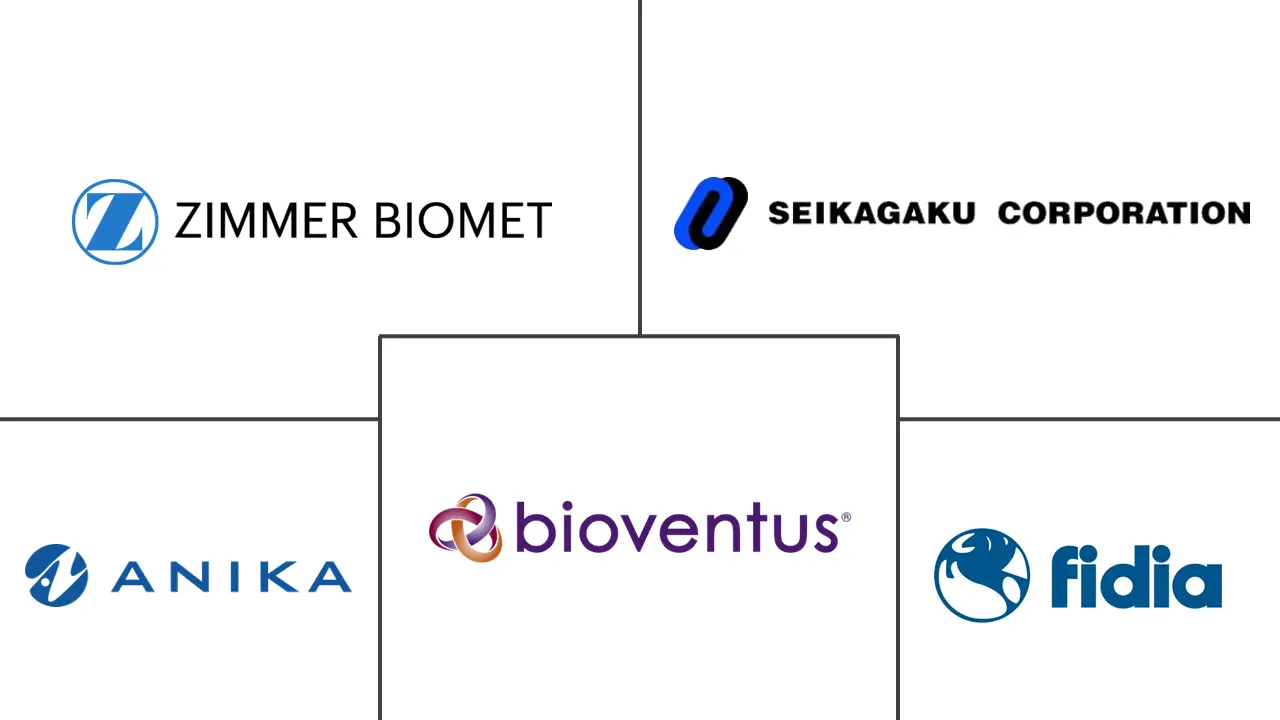Viscosupplementation Market Size and Share
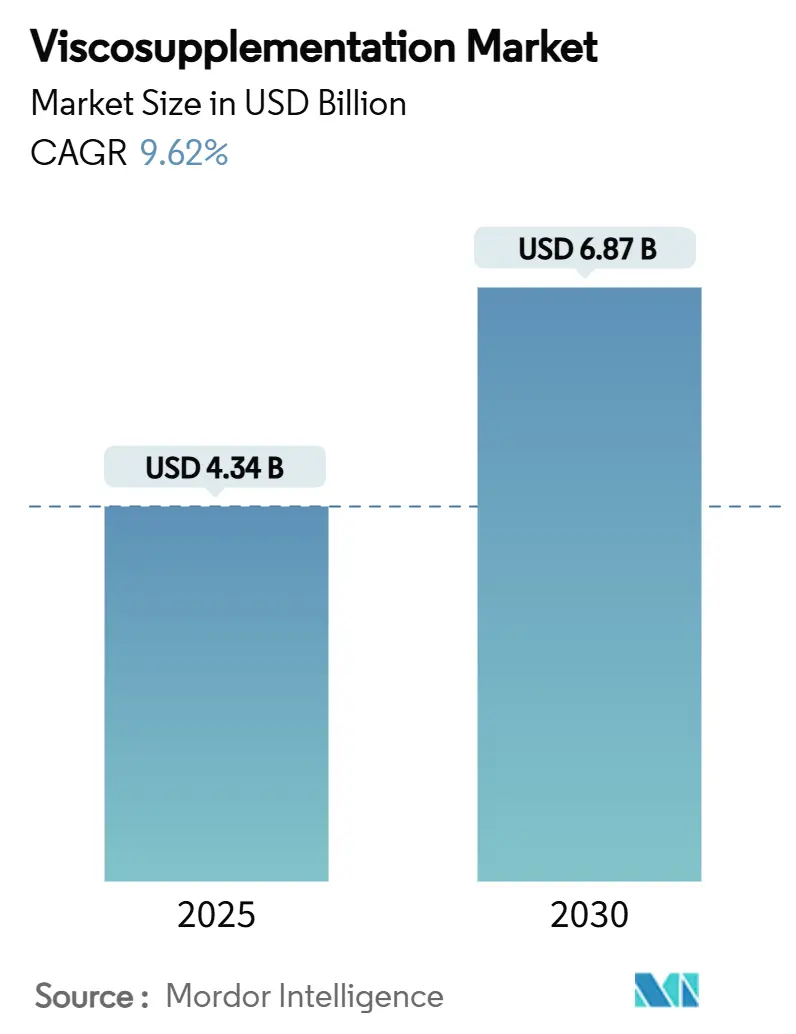
Viscosupplementation Market Analysis by Mordor Intelligence
The viscosupplementation market size stands at USD 4.34 billion in 2025 and is forecast to reach USD 6.87 billion by 2030, advancing at a 9.62% CAGR over the period. Growth rests on three pillars: population ageing that lifts osteoarthritis incidence, manufacturing advances that allow high-purity hyaluronic acid at scale, and clinical guidelines that increasingly recommend single-injection protocols over multi-dose regimens. In practice, viscosupplementation postpones total knee replacement by a mean of 2.6 years, trimming episode-of-care costs while sustaining mobility for millions of patients. Regionally, Asia-Pacific sets the fastest pace at a 10.02% CAGR as reimbursement coverage widens and ambulatory centers proliferate, whereas North America commands the largest revenue share at 42.07% underpinned by broad HCPCS code usage. The competitive field remains moderately concentrated; leading producers differentiate through molecular-weight tailoring, while regulatory uncertainty tied to potential FDA device-to-drug reclassification injects risk but also raises entry barriers.
Key Report Takeaways
- By dosage, single-injection products held 46.28% of the viscosupplementation market share in 2024 and are expanding at the segment-leading 9.94% CAGR to 2030.
- By product source, avian-derived hyaluronic acid led with 54.41% revenue share in 2024, while fermentation-based alternatives are growing at 9.78% CAGR.
- By application site, knee injections accounted for 74.59% of the viscosupplementation market size in 2024; the Others segment is expected to register the fastest 10.63% CAGR.
- By end-user, hospitals retained 42.36% revenue in 2024, whereas ambulatory surgical centers post a 10.15% CAGR through 2030.
- By geography, Asia-Pacific records the highest 10.02% CAGR; North America remains the largest regional market with 42.07% share in 2024.
Global Viscosupplementation Market Trends and Insights
Drivers Impact Analysis
| Driver | (~) % Impact on CAGR Forecast | Geographic Relevance | Impact Timeline |
|---|---|---|---|
| Ageing-Linked OA Prevalence Surge | +2.1% | Global, with peak impact in North America & Europe | Long term (≥ 4 years) |
| Shift to Single-Injection HA Regimens | +1.8% | Global, led by North America and Asia-Pacific | Medium term (2-4 years) |
| Product Approvals & Reimbursement Expansions | +1.4% | North America & Europe, expanding to Asia-Pacific | Medium term (2-4 years) |
| Fermentation-Based Vegan HA Supply Scalability | +1.2% | Global, with manufacturing concentrated in Asia-Pacific | Long term (≥ 4 years) |
| Ultrasound-Guided Injections in ASC Networks | +1.0% | North America & Europe, expanding to Asia-Pacific | Medium term (2-4 years) |
| Regenerative Combo Injectables | +0.8% | Global, with early adoption in North America | Long term (≥ 4 years) |
| Source: Mordor Intelligence | |||
Ageing-Linked OA Prevalence Surge
Worldwide osteoarthritis cases climbed to 607 million in 2021, with knee disease making up more than 56% of the burden. The age-standardized prevalence rate[1]Zihao Wang, “Global, regional and national burden of osteoarthritis in 1990–2021: a systematic analysis of the global burden of disease study 2021,” BMC Musculoskeletal Disorders, bmcmusculoskeletdisord.biomedcentral.com rose from 6,393.1 to 6,967.3 per 100,000. Obesity contributes approximately 4.43 million disability-adjusted life years, amplifying joint degeneration severity. Health-economic analyses show viscosupplementation delays knee arthroplasty and lowers lifetime treatment expense, positioning the therapy as a fiscal lever for payers coping with an ageing base.
Shift to Single-Injection HA Regimens
Randomized trials confirm that single-injection hyaluronic acid provides pain relief comparable to multi-dose courses while reducing clinic visits. FDA clearance of Monovisc, the first single-injection, non-animal product, accelerated adoption. Yet head-to-head studies[2]Selim Safali, “Evaluation of single and multiple hyaluronic acid injections at different concentrations with high molecular weight in the treatment of knee osteoarthritis,” BMC Musculoskeletal Disorders, bmcmusculoskeletdisord.biomedcentral.com show three low-dose injections can yield better functional scores than one high-dose shot. Manufacturers are therefore raising molecular weight to prolong residence time, aiming to reconcile convenience with peak efficacy.
Product Approvals & Reimbursement Expansions
Recent FDA clearances, such as Hymovis, underscore regulators’ focus on demonstrable clinical outcomes over bioequivalence alone. U.S. payers now reimburse distinct HA codes J7318-J7329, although prior-authorization rules have tightened. The 2025 Physician Fee Schedule[3]Centers for Medicare & Medicaid Services, “Medicare and Medicaid Programs; CY 2025 Payment Policies Under the Physician Fee Schedule and Other Changes to Part B Payment and Coverage Policies; Medicare Shared Savings Program Requirements; Medicare Prescription Drug Inflation Rebate Program; and Medicare Overpayments,” federalregister.gov revises practice-expense RVUs, influencing provider margins. Companies with robust evidence portfolios enjoy smoother market entry, whereas products lacking comparative data face formulary pushback.
Fermentation-Based Vegan HA Supply Scalability
Engineered Streptococcus zooepidemicus fermentation now yields up to 4.38 g/L hyaluronic acid through refined precursor balance and gene-expression control. This route avoids animal-derived raw materials and reduces exposure to H5N1 supply shocks. It also lets producers tailor ultra-high molecular weight grades[4]Filippo Migliorini, “Comparison of Different Molecular Weights of Intra-Articular Hyaluronic Acid Injections for Knee Osteoarthritis: A Level I Bayesian Network Meta-Analysis,” Biomedicines, mdpi.com that clinical meta-analyses associate with superior pain relief. Marine by-products, such as mussel wastewater substrates, present additional feedstock options, deepening supply resilience.
Restraints Impact Analysis
| Restraint | (~) % Impact on CAGR Forecast | Geographic Relevance | Impact Timeline |
|---|---|---|---|
| Clinical-Efficacy Debate & Payer Push-Back | -1.9% | Global, with highest impact in North America & Europe | Medium term (2-4 years) |
| FDA Device-to-Drug Re-Classification Risk | -1.1% | North America, with potential spillover to other regions | Short term (≤ 2 years) |
| Avian-Supply Shocks from H5N1 Outbreaks | -0.9% | Global, with highest impact on avian-derived HA supply | Short term (≤ 2 years) |
| Growing Adoption of PRP/MSCs as Substitutes | -0.7% | Global, led by North America and Europe | Medium term (2-4 years) |
| Source: Mordor Intelligence | |||
Clinical-Efficacy Debate & Payer Push-Back
The American College of Rheumatology and the American Academy of Orthopaedic Surgeons classify viscosupplementation evidence as limited, fueling insurer caution. Meta-analyses show high study heterogeneity, allowing payers to impose step-therapy criteria that favor NSAIDs or corticosteroids first. Platelet-rich plasma now records stronger long-term results in several trials, prompting coverage committees to revisit HA reimbursement. Providers must compile detailed conservative-treatment histories to secure payment, elevating the administrative load.
FDA Device-to-Drug Reclassification Risk
Following the Genus court ruling, FDA signaled plans to re-evaluate hyaluronic acid’s device status, which could trigger costlier, drug-style trials and longer review clocks. The prospect complicates R&D budgeting and may advantage larger pharma players able to fund phase III programs. Firms thus maintain dual dossier strategies to hedge against final classification outcomes.
Segment Analysis
By Dosage: Single-Injection Convenience Drives Adoption
Single-injection products captured 46.28% of the viscosupplementation market share in 2024 and command a 9.94% CAGR to 2030. The Viscosupplementation market size tied to single-dose regimens is forecast at USD 3.47 billion in 2030. The popularity stems from reduced clinic time and lower procedural fees. Three-injection courses retain relevance for patients needing incremental symptom control, while five-shot regimens serve severe bilateral disease.
Clinical data show concentrated cross-linked preparations sustain symptom relief over 60 days. Ongoing formulation work seeks to match the functional gains of multi-dose protocols by boosting viscoelasticity and residence time of single shots. Manufacturers exploit this clinical tension to position premium high-molecular-weight brands at the intersection of convenience and efficacy.
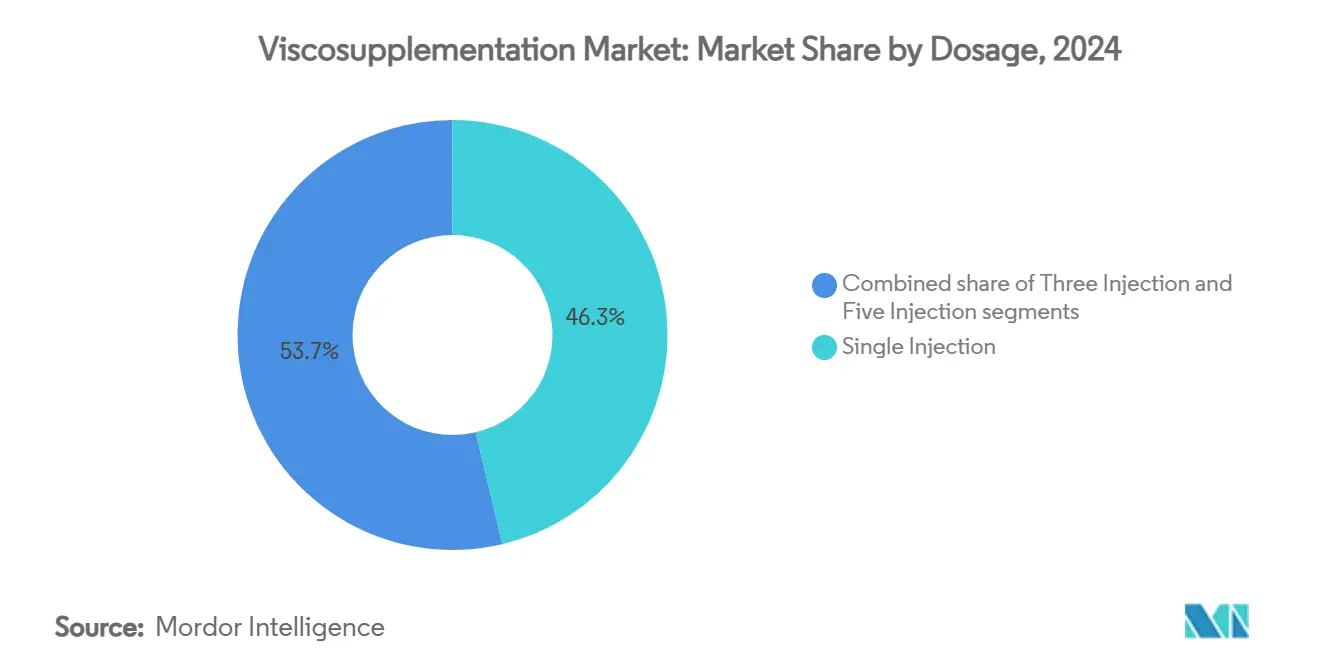
Note: Segment shares of all individual segments available upon report purchase
By Product Source: Fermentation Gains Ground Despite Avian Dominance
Avian sources held 54.41% of the viscosupplementation market size in 2024, thanks to decades of clinical familiarity. However, fermentation products grow 9.78% annually as the Viscosupplementation market prioritizes supply security and vegan labelling. The Viscosupplementation market size for non-avian HA is projected to reach USD 3.15 billion by 2030.
Process innovation allows bespoke molecular-weight spectra without the viral-contamination risks linked to rooster comb extract. Companies hedge by running parallel avian and fermentation lines, but long-range capex tilts toward fermenters located in China and South Korea, where feedstock and utilities cost less.
By Application Site: Knee Dominance Masks Emerging Opportunities
Knee injections delivered 74.59% revenue in 2024, representing the largest slice of the viscosupplementation market share. Others segment pace the field at a 10.63% CAGR.
Ultrasound guidance now enables accurate hip access under local anesthetic, improving patient tolerance and expanding referral volumes. In the shoulders, viscosupplementation eases glenohumeral stiffness in seniors unable to undergo arthroplasty. As device makers roll out narrow-gauge needles and portable imaging, orthopedists broaden HA use beyond knees, seeding new revenue layers.
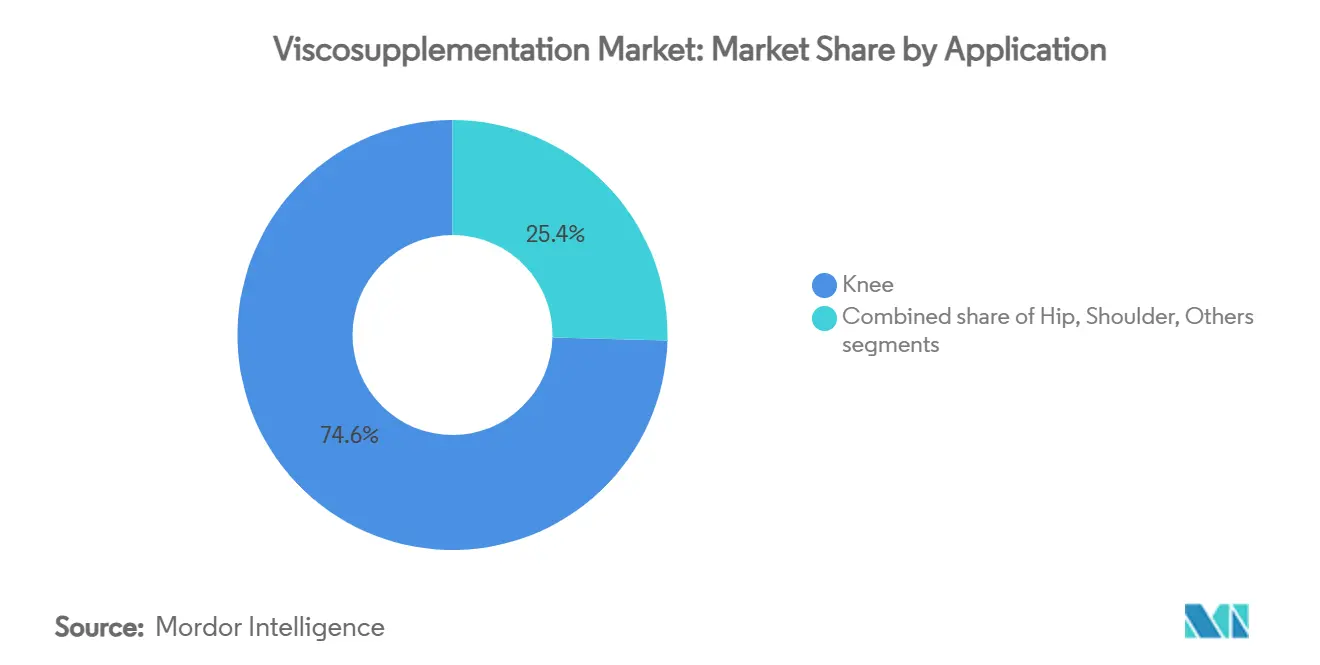
By End-User: ASCs Capitalize on Efficiency Trends
Hospitals held 42.36% of the viscosupplementation market share in 2024, yet ambulatory surgical centers (ASCs) record a 10.15% CAGR through 2030, the fastest among care settings.
ASC growth rides on bundled-payment models that reward lower facility fees and same-day discharge. Portable ultrasound lowers setup cost, letting clinics perform injections in procedure rooms rather than fluoroscopy suites. Orthopedic and sports medicine offices occupy a middle ground, retaining loyal athlete populations while referring complex geriatric cases back to hospital groups.
Geography Analysis
North America contributed 42.07% of the viscosupplementation market share in 2024 and is forecast to grow at 9.57% CAGR until 2030. HCPCS codes J7318-J7329 assure reimbursement continuity, but payers are tightening prior-authorisation rules that lengthen approval cycles. FDA product clearances sustain pipeline momentum, yet looming device-to-drug reclassification could inflate compliance spending, particularly for smaller entrants. Distribution partnerships, such as the renewal between Anika Therapeutics and Pendopharm that extends to 2030, reinforce market depth.
Asia-Pacific registers the top 10.02% CAGR, driven by urban hospitals adopting minimally invasive pain procedures and by domestic HA producers scaling fermentation capacity. Government import-substitution policies in China and India nudge buyers toward local brands, trimming landed cost. Rising life expectancy and joint-disease prevalence in Japan and South Korea sustain demand even in mature payer environments.
Europe advances at 9.13% CAGR under the strict EU Medical Devices Regulation that mandates post-market performance studies. The paperwork burden weeds out small labelers, handing advantage to well-capitalised suppliers. Middle East & Africa follow at 8.96% CAGR on the back of hospital expansion in Gulf Cooperation Council states, whereas South America trails at 8.48% due to fiscal austerity and uneven insurance penetration. Collectively, emerging regions form the next frontier once regulatory clarity and payer frameworks solidify.
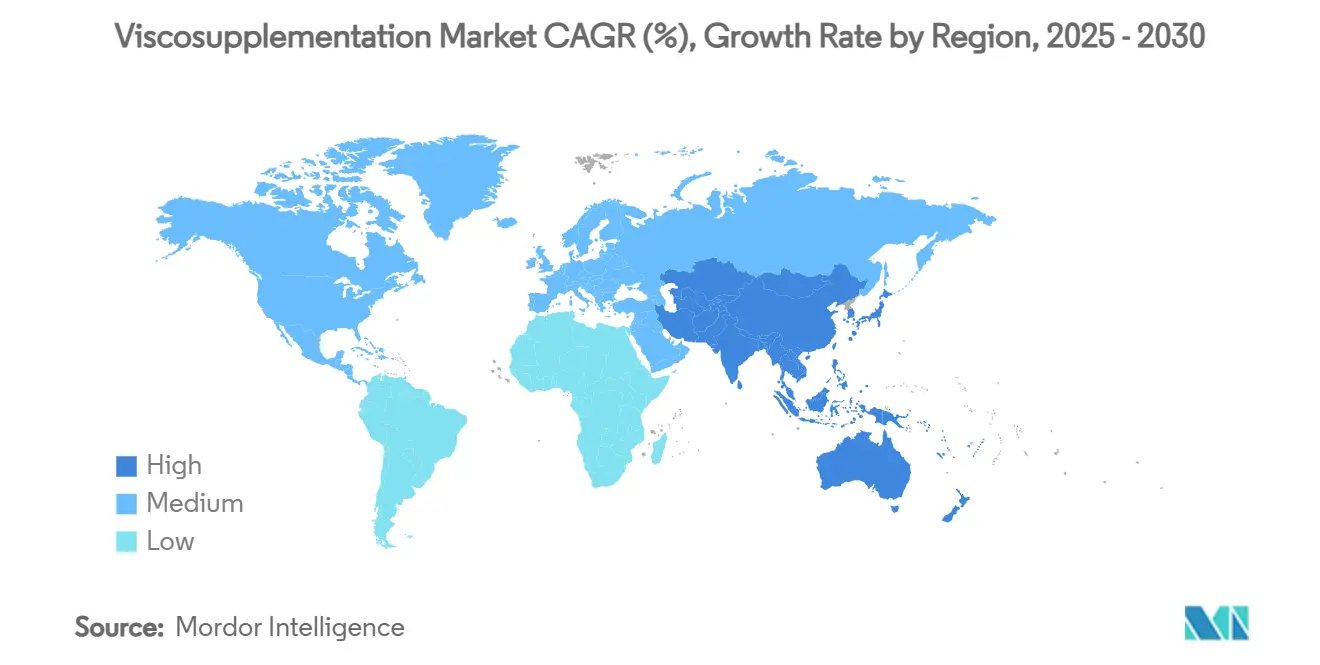
Competitive Landscape
The viscosupplementation market shows moderate concentration: the top five suppliers account for a large chunk of global sales. Anika Therapeutics leads with Orthovisc and Monovisc portfolios, yet its Q3 2024 revenue slipped 7% year on year to USD 38.8 million, reflecting U.S. procedure softness. Bioventus posted Q1 2024 revenue of USD 129 million, up 9%, fuelled by DUROLANE rollouts in new hospital accounts.
Players differentiate on molecular weight, cross-linking chemistry, and injection schedule. Pipeline assets combine hyaluronic acid with platelet-rich plasma to extend symptom relief; early randomized data indicate greater WOMAC score reduction than monotherapy. Firms also invest in handheld ultrasound systems and fine-gauge needle sets that reduce procedure pain, bundling disposables with HA syringes to deepen account loyalty.
Strategic focus remains sharp: Anika divested Parcus Medical in March 2025 to channel resources into core HA technology. Bioventus sold its Advanced Rehabilitation unit for USD 45 million to trim debt and fund viscosupplementation R&D. Midsize peers pursue licensing deals rather than full acquisitions, betting that post-market surveillance costs under EU MDR will drive smaller brands to seek shelter under larger commercial umbrellas.
Viscosupplementation Industry Leaders
-
Anika Therapeutics, Inc.
-
Bioventus Inc.
-
Fidia Farmaceutici S.p.A.
-
Seikagaku Corporation
-
Zimmer Biomet Holdings, Inc.
- *Disclaimer: Major Players sorted in no particular order
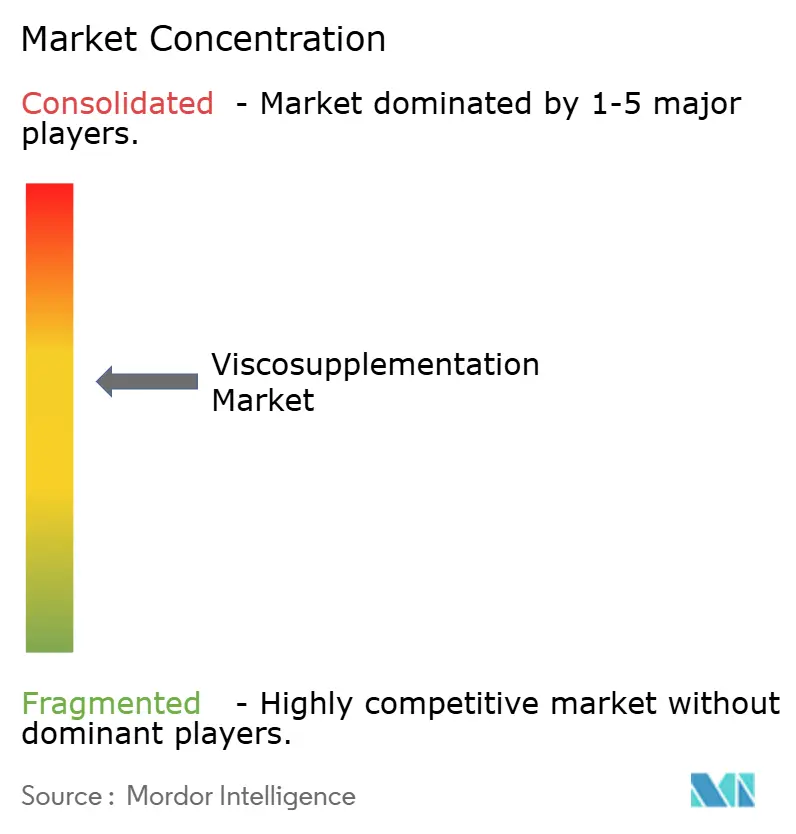


Recent Industry Developments
- March 2025: Anika Therapeutics closed the sale of Parcus Medical to Medacta Group, sharpening its focus on hyaluronic acid pain solutions.
- February 2025: FDA cleared Evolysse hyaluronic acid fillers, reinforcing agency comfort with HA-based therapeutics.
- October 2024: Bioventus divested its Advanced Rehabilitation segment to Accelmed Partners for USD 45 million with contingent earn-outs.
- September 2024: FDA approved Hymovis for knee osteoarthritis in patients unresponsive to first-line therapy, citing non-inferiority to Hyalgan in pivotal studies.
Global Viscosupplementation Market Report Scope
As per the scope of the report, Viscosupplements are the injection of hyaluronic acid which injects into diarthrodial joints, intending to restore the rheological properties of the synovial fluid, thereby producing analgesia, mechanical, chondroprotective, and anti-inflammatory effects. Viscosupplements are usually preferred by healthcare providers to treat osteoarthritis, but then it may also benefit patients with certain other kinds of arthritis, such as rheumatoid arthritis. The Global Viscosupplementation market is segmented by Dosage (Single Injection, Three injections, Five Injections), End-User (Hospitals, Ambulatory Surgical Centers, Others), and Geography (North America, Europe, Asia-Pacific, Middle East, and Africa, South America). The market report also covers the estimated market sizes and trends for 17 countries across major regions globally. The report offers the value (in USD million) for the above segments.
| Single Injection |
| Three Injection |
| Five Injection |
| Avian-derived HA |
| Non-Avian |
| Knee |
| Hip |
| Shoulder |
| Others |
| Hospitals |
| Ambulatory Surgical Centers |
| Orthopedic & Sports Clinics |
| Others |
| North America | United States |
| Canada | |
| Mexico | |
| Europe | Germany |
| United Kingdom | |
| France | |
| Italy | |
| Spain | |
| Rest of Europe | |
| Asia-Pacific | China |
| Japan | |
| India | |
| Australia | |
| South Korea | |
| Rest of Asia-Pacific | |
| Middle East and Africa | GCC |
| South Africa | |
| Rest of Middle East and Africa | |
| South America | Brazil |
| Argentina | |
| Rest of South America |
| By Dosage | Single Injection | |
| Three Injection | ||
| Five Injection | ||
| By Product Source | Avian-derived HA | |
| Non-Avian | ||
| By Application Site | Knee | |
| Hip | ||
| Shoulder | ||
| Others | ||
| By End-User | Hospitals | |
| Ambulatory Surgical Centers | ||
| Orthopedic & Sports Clinics | ||
| Others | ||
| By Geography | North America | United States |
| Canada | ||
| Mexico | ||
| Europe | Germany | |
| United Kingdom | ||
| France | ||
| Italy | ||
| Spain | ||
| Rest of Europe | ||
| Asia-Pacific | China | |
| Japan | ||
| India | ||
| Australia | ||
| South Korea | ||
| Rest of Asia-Pacific | ||
| Middle East and Africa | GCC | |
| South Africa | ||
| Rest of Middle East and Africa | ||
| South America | Brazil | |
| Argentina | ||
| Rest of South America | ||


Key Questions Answered in the Report
What clinical trend is reshaping viscosupplementation protocols?
Single-injection hyaluronic acid regimens are becoming the preferred option because they cut clinic visits and improve patient adherence without compromising pain-relief outcomes.
How are manufacturers securing long-term raw-material supply for hyaluronic acid?
They are scaling fermentation-based, non-animal production methods that deliver consistent molecular-weight profiles and sidestep risks tied to avian-derived sources.
Why are ambulatory surgical centers gaining importance in this market?
Cost-conscious payers favor outpatient facilities, and advances in handheld ultrasound now let clinicians perform guided injections accurately in ASC procedure rooms.
What regulatory shift could alter product development strategies?
A potential FDA move to reclassify hyaluronic acid products from devices to drugs would require more extensive clinical trials, raising both timelines and investment thresholds.
Which combination therapy is emerging as a promising alternative to monotherapy?
Co-injection of hyaluronic acid with platelet-rich plasma is showing superior improvements in pain relief and joint function compared with hyaluronic acid alone.
How are payers influencing viscosupplementation adoption?
Insurers are tightening prior-authorization rules and demanding documented failure of conservative treatments, nudging clinicians toward evidence-rich products and competitive pricing.
Page last updated on:
